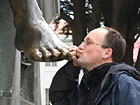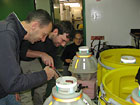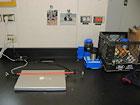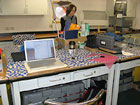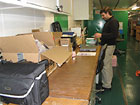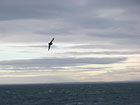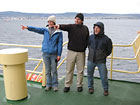

 | |||||||||||||||||||||||||||||||||||||||||
|
|
Journals 2007/2008Mark Goldner
November 14, 2007 52° 51' S, 67° 50' W And we're off! The Nathaniel B. Palmer has begun its Drake Passage "cruise." The first part of our cruise took us up the Strait of Magellan. This is the waterway that passes between mainland South America and a large island known as Tiera del Fuego. The Strait was named after the Portuguese explorer Hernando de Magellan, who discovered this waterway. (He then went on to be the first European to discover the Pacific Ocean.) In the center of Punta Arenas is a statue of this famous explorer. Tradition holds that travelers who sail across the Drake Passage should kiss the big toe of one of the statues on the monument as good luck. Safe return to Punta Arenas is then assured. Well, I stood in for the science team and did my good luck duty.
Last minute preparations
I took the opportunity this morning to do my laundry on the ship. This may not seem like much to write about, but when crossing the Drake it's important to be strategic about when you do your laundry. Once we hit large waves and the ship begins to roll a lot, then the washing machines won't work. I figured it would be best to do it before we started to move. Into the wild blue yonder
Now that we've entered the Atlantic Ocean, we have to cut South. Next we'll travel around the southern tip of Tiera del Fuego for our first "waypoint". This will be our first stop, where we'll be deploying the first of many "CPIES" instruments. We will also be doing a "Current Mooring" deployment - this will help measure the current at various depths in the ocean. About an hour after we left port we had a safety meeting. It felt a little like a cross between the routines you go through on the first day of school and the safety demonstration you get on an airplane. In addition to all the routines of how the ship runs and the dos and don'ts (including which seats you should avoid in the mess hall because the captain and officers always sit there!), we went through all the procedures in case of an emergency. Then we got to test out our lifejackets and "immersion suits". These suits are designed to keep you afloat and warm in case we had to abandon ship. They are known as the "gumby suits"; can you guess why? Finally, we went into the lifeboats to see how to get in and strap yourself in. Every week or so there will be an emergency drill.
This morning I got up and took a nice stroll around deck. After breakfast I spent a little while up on the bridge. I've noticed that a large number of sea birds seem to be attracted to the ship.
For the first few hours the seas have been fairly calm. This boat is very stable, and aside from some gentle rolling it's not much different from being on land. I'm sure this will change before too long! I learned this morning that the tides in the vicinity of the Magellan Strait are enormous. In some places the difference in water height from low to high tide can be over 30 feet! Apparently this is partly due to the shape of the continental shelf. What we think of as the "continent" extends many miles into the ocean - in reality part of every continent is submerged under water. So because the shape of the continental slope is so steep, this magnifies the size of the tide on shore.
|
||||||||||||||||||||||||||||||||||||||||

